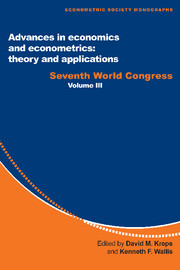Book contents
- Frontmatter
- 1 Causal analysis and statistical inference on possibly non-stationary time series
- 2 Cointegration, long-run comovements, and long-horizon forecasting
- 3 Testing and measurement in competition models
- 4 Empirical equilibrium search models
- 5 Posterior simulators in econometrics
- 6 Restricted least squares subject to monotonicity and concavity constraints
- 7 Bootstrap methods in econometrics: theory and numerical performance
- 8 Econometric models of option pricing errors
- 9 New minimum chi-square methods in empirical
- Index
1 - Causal analysis and statistical inference on possibly non-stationary time series
Published online by Cambridge University Press: 05 January 2013
- Frontmatter
- 1 Causal analysis and statistical inference on possibly non-stationary time series
- 2 Cointegration, long-run comovements, and long-horizon forecasting
- 3 Testing and measurement in competition models
- 4 Empirical equilibrium search models
- 5 Posterior simulators in econometrics
- 6 Restricted least squares subject to monotonicity and concavity constraints
- 7 Bootstrap methods in econometrics: theory and numerical performance
- 8 Econometric models of option pricing errors
- 9 New minimum chi-square methods in empirical
- Index
Summary
INTRODUCTION
The purpose of this chapter is to provide a method of quantitative characterization of the interactive structure between a pair of possibly non-stationary vector time series by the means of causal measures (which consist of the measures of association, one-way effect, and reciprocity) and to consider the statistical inference problems involved in estimating those measures. Those measures were introduced in Hosoya (1991) in connection with the problem of extracting from each of a pair of stationary processes the component process which causes the other in purely one-way or feedback free manner in the sense of the Granger causality. All of the three measures have the advantage of frequency-wise decomposability and enable us to see how two time series interact in frequency bands of interest (see also Geweke (1982, 1984) for an important forerunner of this approach). We extend this approach to possibly non-stationary time series and deal with the related inference problems. By that extension, we are able to discern naturally the long-run and the short-run effects one series has on the other even when they contain stochastic trends, whereas as Stock and Watson (1988) pointed out, such distinctions are not feasible by means of time-domain representation of time series unless some convention is imposed.
- Type
- Chapter
- Information
- Advances in Economics and Econometrics: Theory and ApplicationsSeventh World Congress, pp. 1 - 33Publisher: Cambridge University PressPrint publication year: 1997
- 4
- Cited by

